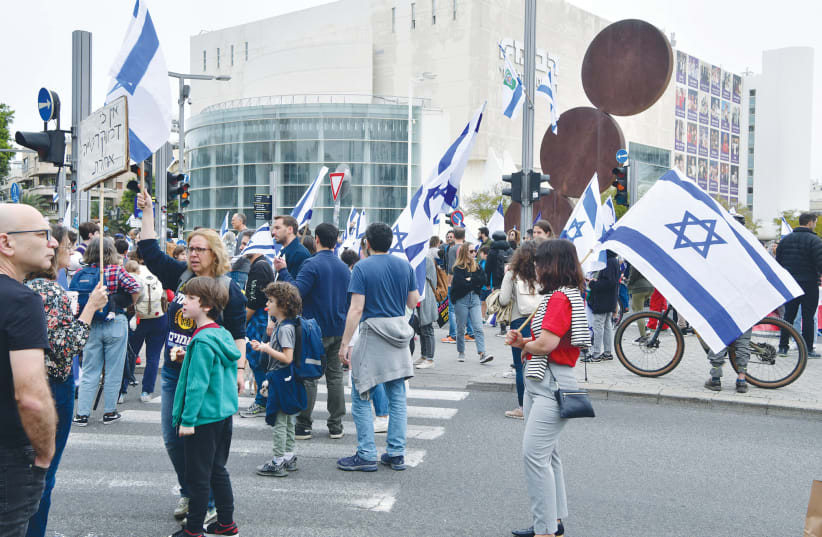Demonstrating has become a big part of life for many Israelis.
As the government forges ahead with its plans to reform the judiciary, hundreds of thousands come out each week to stand together against the prospect of a slow and steady decline of democracy.
Many of the demonstrations that have taken place across the country have been peaceful and largely uneventful.
Some, including my own weekly gathering in Netanya, have become family affairs, where children are not an unfamiliar sight.
A few weeks ago, for example, I bumped into a lovely young couple from my building who were there with their children, a three-year-old girl, and a newborn in her baby carriage. They even brought the dog along for good measure. We all chatted amicably, as people milled around waving their flags and singing along with the rest of the crowd.
And they were not alone. As I looked around, I noticed lots of other kids running around, or sitting on their parent’s shoulders, all enjoying a fun family night out.
Sadly, however, not all demos are child-friendly; things can turn ugly in a heartbeat – as was the case on Tuesday when the coalition advanced the reasonableness bill. In a desperate bid to halt this appalling turn of events, plans to “escalate the struggle” were set in motion with a “day of disruption.”
Widespread demonstrations in various locations up and down the country, including the Knesset, Ben-Gurion Airport, and the US Embassy Office in Tel Aviv, almost brought the country to its knees. Main arteries were blocked as demonstrators spilled onto the highways leading to Jerusalem, Haifa, and Tel Aviv.
Even before daybreak on Tuesday, it was clear that things could get ugly. Water cannon, a dangerous tool increasingly used by the Israel police as a method of dispersal, would almost certainly be deployed, as well as mounted police, neither of which is kid-friendly, in anyone’s view.
Best to let the little ones sit this one out, for safety’s sake.
Some didn’t do this, however.
One video from the day shows mounted police pushing into a crowd of protesters on a sidewalk in Tel Aviv. Alarmingly, children were among their number, all of whom were forced to run to avoid being trampled.
What were they doing there in the first place? You might ask.
Is it irresponsible to take children to a demonstration?
WHEN I recently posed this question on a social media platform, the answers were varied.
There were those who boldly asserted that it was indeed irresponsible, irrespective of the size, location, and purpose, of the demonstration.
Others, including British-born Israeli Judy Milston Bogen, posited a different view. “From a certain age, it is good to take them,” she said. “Gotta start somewhere!” another added.
When it comes to taking little ones, common sense is key. Susan Lewis Hadash, an American-Israeli, gives the following advice to those who may be considering it: “I would be very careful about taking children to a demonstration. Whoever does so should stay at the periphery of the demonstration and not at the center, where it would be hard to get out. Also, I would not take them anywhere where police are likely to use water cannons, etc. such as the Ayalon Highway.”
Clearly, not all demonstrations are the same; some are peaceful and friendly, whereas others are fraught, unpleasant gatherings that could boil over at any moment, sparking violence.
One city, which has seen its fair share of demos over the years is London.
According to Liz Sewell, who lives in Britain’s capital, demonstrations often turn ugly there. “As demonstrations become more polarized, it becomes easier for people to advocate violence,” she said.
“Check out the Trans Pride event on Saturday in London where the demonstrators were advised to punch TERFs [a term coined by trans activists to denote those who oppose their ideology]. You would not want children to be part of that. I think things are getting darker and that we will see more violence.” she lamented.
Hannah Lyons-Singer, another Londoner, expresses a different view. Having been taken along by her parents to various demos as a child, she now takes her own brood with her when the need to stand up and fight arises. “I was taken on dozens and dozens [of demos]! What’s wrong with taking kids on demos?” she asks.
Emma Phillips, a British-Israeli, also has positive memories of demonstrating in London: “An abiding memory is going to a very large pro-Israel rally in Trafalgar Square, attended by Bibi,” she began. “We took a bus load from our shul, and, to our surprise, a few small kids were brought along.
“I will never forget, as we arrived, how one of our number, a survivor of many [concentration] camps and one of the ‘boys,’ immediately took charge, marched us in a column, to a good spot, formed us into a square – and placed the children in the center. Sadly, he was only too practiced at this.”
Demonstrating and democracy go hand in hand; it is a precious gift that should not be wasted. In Israel today, where our democracy is under threat, exercising our right to demonstrate is more pressing than ever.
In certain circumstances, while it may be ill-advised to take children to a demo, for some, there is no option, as many here in Israel have found in recent months. With the school vacation upon us, and childcare being unaffordable for most, it’s a question of priorities.
Playing your part – by showing up to a demonstration that could be instrumental in shaping the future of this country, thus ensuring a better future for our children – is crucial for many. If there’s nowhere else for them to go, the kids come too – it’s as simple as that.
Although in some cases, they may be too young to appreciate why they, and everyone else, are there, by “demonstrating” to them that we have the right to speak up for what we believe in, we instill a sense of purpose and belief in these youngsters that cannot be replicated elsewhere.
The writer is a former lawyer from Manchester, England. She now lives in Israel where she works at The Jerusalem Post.

